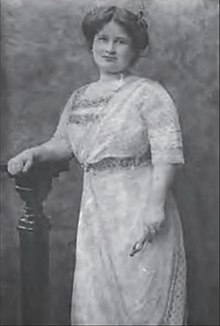Saliha Naciye Hanım
| Saliha Naciye Hanım | |||||
|---|---|---|---|---|---|
 | |||||
| Born | Zeliha Ankuap 1887 Batumi , Georgia | ||||
| Died | 1925 (aged 37–38) Serencebey Mansion, Istanbul, Turkey | ||||
| Burial | Mahmud II Mausoleum, Divan Yolu street, Istanbul | ||||
| Spouse | |||||
| Issue more... | Şehzade Mehmed Abid | ||||
| |||||
| House | Ankuap (by birth) Ottoman (by marriage) | ||||
| Father | Arslan Ankuap | ||||
| Religion | Sunni Islam , previously Orthodox Christianity | ||||
Saliha Naciye Hanım[a] (Ottoman Turkish: صالحہ ناجیہ خانم; born Zeliha Ankuap; 1887 – 1925) was the favorite concubine of Sultan Abdul Hamid II of the Ottoman Empire.[2]
Early life[]
Of Abkhazian origin,[3] Saliha Naciye Hanım was born in 1887.[4] Born as Zeliha Ankuap, she was the daughter of Aslan Bey Ankuap.[3] In 1901, Kabasakal Mehmed Pasha, presented her for service in the Yıldız Palace,[5] where her name according to the custom of the Ottoman court was changed to Saliha Naciye.[6]
Marriage[]
Three years into service, Abdul Hamid took notice of Saliha Naciye, and they married on 4 November 1904 in the Yıldız Palace.[4] She was given the title of "Sixth Ikbal".[7] A year after the marriage, on 17 September 1905, she gave birth to her first child, a son, Şehzade Mehmed Abid,[8][9] and three years later on 16 January 1909 to her second child, a daughter, Samiye Sultan, who died on 24 January 1909.[10]
In the 1909 mutiny, Kabasakal ("twisted beard") was shaved and publicly hanged,[11] and on 27 April 1909, Abdul Hamid was deposed, and sent into exile in Thessaloniki.[12] Naciye was close to him,[13] and so she and her son Abid accompanied him. But after Thessaloniki fell to Greece in 1912, she returned to Istanbul with Abdul Hamid, and settled in the Beylerbeyi Palace,[7][14] where he died in 1918.[15]
Last years and death[]
After Abdul Hamid's death, Saliha Naciye settled in the mansion of Şehzade Mehmed Selim located in Serencebey.[16] At the exile of the imperial family in March 1924, she remained in Istanbul. On 14 January 1925, she gave the power of attorney to Sami Günzberg, a well-known Turkish Jewish lawyer, authorising him to regain from usurpers buildings, lands, mines, concessions left by Abdul Hamid situated in Turkish territory and elsewhere.[17]
She died in 1925, and was buried in the mausoleum of Sultan Mahmud II, located at Divan Yolu street.[18][19]
Issue[]
| Name | Birth | Death | Notes |
|---|---|---|---|
| Şehzade Mehmed Abid | 17 September 1905[20][7][21] | 29 May 1929[20][7][21] | married twice without issue |
| Samiye Sultan | 16 January 1907[20][10] | 24 January 1909[20][10] | born and died in Yıldız Palace, and buried in Yahya Efendi Cemetery |
In literature and popular culture[]
- Saliha Naciye Hanım is a character in Tim Symonds' historical novel Sherlock Holmes and The Sword of Osman (2015).[22]
- In the 2017 TV series Payitaht: Abdülhamid, Saliha Naciye Hanım is portrayed by Turkish actress Vildan Atasever.[23]
See also[]
Annotations[]
References[]
- ^ Banoğlu, Niyazi Ahmet (1963). Anitlari ve tarihî eserleriyle Istanbul. Yeni C̣iǧir Kitabevi. p. 56.
- ^ Açba, Leyla (2004). Bir Çerkes prensesinin harem hatıraları. L & M. p. 123. ISBN 978-9-756-49131-7.
- ^ a b Ali Akyıldız (2018). Son Dönem Osmanlı Padişahlarının Nikâh Meselesi. pp. 697–98.
- ^ a b Yılmaz, Ö.F. (2002). Sultan Abdülhamit Han'ın harem hayatı. Eylül Yayınları. Eylül Yayınları. p. 95. ISBN 978-975-6597-15-6.
- ^ Sakaoğlu 2008, p. 681.
- ^ Nahid Sırrı Örik (1989). Abdülhamid'in haremi. Arba. p. 41.
- ^ a b c d Uluçay 2011, p. 252.
- ^ Bey, Mehmet Sürreya (1969). Osmanlı devletinde kim kimdi, Volume 1. Küğ Yayını. p. 126.
- ^ Ali Vâsib (2004). Bir Şehzadenin hâtırâtı: vatan ve menfâda gördüklerim ve işittiklerim. YKY. p. 73. ISBN 978-9-750-80878-4.
- ^ a b c Uluçay 2011, p. 259.
- ^ McCullagh, Francis (1910). The Fall of Abd-ul-Hamid. London: Methuen & Co. Ltd. p. 274.
- ^ Hall, Richard C. (October 9, 2014). War in the Balkans: An Encyclopedic History from the Fall of the Ottoman Empire to the Breakup of Yugoslavia. ABC-CLIO. pp. 1–2. ISBN 978-1-610-69031-7.
- ^ Tuğlacı, Pars (1985). Türkiyeʼde kadın, Volume 3. Cem Yayınevi. pp. 165, 195.
- ^ Sakaoğlu 2008, p. 681-2.
- ^ Parry, Milman; Lord, Albert B. (1979). Serbocroatian heroic songs, Volume 1. Harvard University Press. p. 371.
- ^ Akyıldız, Ali (2018). Son Dönem Osmanlı Padişahlarının Nikâh Meselesi. p. 701.
- ^ Kark, Ruth; Frantzman, Seth J. (2010). "One of the most spectacular lawsuits ever launched": Abdülhamid's heirs, his lands and the land case in Palestine, 1908-1950. p. 138.
- ^ Şehsuvaroğlu, Haluk Y. (2005). Asırlar boyunca İstanbul: Eserleri, Olayları, Kültürü. Yenigün Haber Ajansı. p. 223.
- ^ Banoğlu, Niyazi Ahmet (1963). Anitlari ve tarihi eserleriyle Istanbul. Yeni çigir kitabevi. p. 56.
- ^ a b c d Osmanoğlu 2000, p. 264.
- ^ a b Brookes 2010, p. 278.
- ^ Symonds, Tim (October 14, 2015). Sherlock Holmes and The Sword of Osman. Andrews UK Limited. ISBN 978-1-780-92756-5.
- ^ Payitaht: Abdülhamid (TV Series 2017– ), retrieved 2020-12-29
- ^ Sakaoğlu 2008, p. 680.
- ^ Örik, Nahid Sırrı (2002). Bilinmeyen yaşamlarıyla saraylılar. Türkiye İş Bankası. p. 145. ISBN 978-9-754-58383-0.
Sources[]
- Brookes, Douglas Scott (2010). The Concubine, the Princess, and the Teacher: Voices from the Ottoman Harem. University of Texas Press. ISBN 978-0-292-78335-5.
- Osmanoğlu, Ayşe (2000). Babam Sultan Abdülhamid. Mona Kitap Yayinlari. ISBN 978-6-050-81202-2.
- Sakaoğlu, Necdet (2008). Bu Mülkün Kadın Sultanları: Vâlide Sultanlar, Hâtunlar, Hasekiler, Kandınefendiler, Sultanefendiler. Oğlak Yayıncılık. ISBN 978-6-051-71079-2.
- Uluçay, M. Çağatay (2011). Padişahların kadınları ve kızları. Ötüken. ISBN 978-9-754-37840-5.
- Wives of Ottoman sultans
- 1882 births
- People of the Ottoman Empire of Georgian descent
- People from Batumi
- Concubines of the Ottoman Empire
- 1923 deaths
- People of the Ottoman Empire of Abkhazian descent
- Abdul Hamid II

